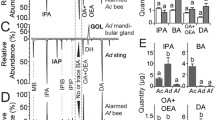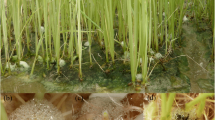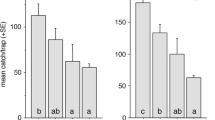Abstract
The Western flower thrips Frankliniella occidentalis produces conspicuous anal droplets that function as a direct defense against various predators. These droplets also function in pheromonal communication in that they contain a mixture of decyl acetate and dodecyl acetate, which acts as an alarm. Exposure of thrips to synthetic pheromone is known to promote takeoff or refuge seeking, but the effect of the natural pheromone has not yet been studied. Here, we not only studied the response to natural pheromone, but also tested the new hypothesis that the alarm pheromone primes a defensive response in thrips. This test was carried out by measuring the reaction time to a simulated predator attack after exposure to synthetic or natural alarm pheromone (against a control with no pheromone at all). The reaction was quantified in terms of the time it takes a thrips larva to produce a droplet after attack. We found that thrips larvae produce droplets of alarm pheromone faster when cues associated with danger are present. There were no significant differences in reaction times of responses to synthetic pheromone, natural pheromone, or odors from a patch with a predator attacking a thrips larva. This implies that the synthetic pheromone mimics the natural pheromone, and that other cues emanating from the predator play a minor role. We conclude that the alarm pheromone increases the vigilance of the thrips, and this may promote its survival.

Similar content being viewed by others
References
Bakker, F. M. and Sabelis, M. W. 1987. Attack success of Amblyseius mckenziei and the stage related defensive capacity of thrips larvae. Neth. J. Zool. 37:437–437.
Bakker, F. M. and Sabelis, M. W. 1989. How larvae of Thrips tabaci reduce the attack success of phytoseiid predators. Entomol. Exp. Appl. 50:47–51.
Lima, S. L. and Dill, L. M. 1990. Behavioral decisions made under the risk of predation—a review and prospectus. Can. J. Zool. 68:619–640.
Macdonald, K. M., Hamilton, J. G. C., Jacobson, R., and Kirk, W. D. J. 2002. Effects of alarm pheromone on landing and take-off by adult western flower thrips. Entomol. Exp. Appl. 103:279–282.
Macdonald, K. M., Hamilton, J. G. C., Jacobson, R., and Kirk, W. D. J. 2003. Analysis of anal droplets of the Western flower thrips Frankliniella occidentalis. J. Chem. Ecol. 29:2385–2389.
Teerling, C. R., Pierce, H. D., Borden, J. H., and Gillespie, D. R. 1993a. Identification and bioactivity of alarm pheromone in the Western flower thrips, Frankliniella occidentalis. J. Chem. Ecol. 19:681–697.
Teerling, C. R., Gillespie, D. R., and Borden, J. H. 1993b. Utilization of Western flower thrips alarm pheromone as a prey-finding kairomone by predators. Can. Entomol. 125:431–437.
van den Meijracker, R. A. F. 1994. Life history evolution in mass rearing of Orius insidiosus. Proc. Exp. Appl. Entomol. 5:25–30.
Venzon, M., Janssen, A., and Sabelis, M. W. 1999. Attraction of a generalist predator towards herbivore-infested plants. Entomol. Exp. Appl. 93:305–314.
Author information
Authors and Affiliations
Corresponding author
Additional information
An erratum to this article can be found at http://dx.doi.org/10.1007/s10886-006-9132-x
Rights and permissions
About this article
Cite this article
de Brujin, P.J.A., Egas, M., Janssen, A. et al. Pheromone-Induced Priming of a Defensive Response in Western Flower Thrips. J Chem Ecol 32, 1599–1603 (2006). https://doi.org/10.1007/s10886-006-9092-1
Received:
Revised:
Accepted:
Published:
Issue Date:
DOI: https://doi.org/10.1007/s10886-006-9092-1




